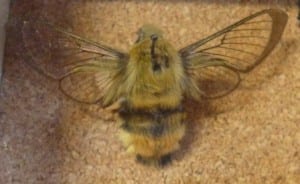Specimen of the Week: Week Forty-Six
By Emma-Louise Nicholls, on 28 August 2012
 I think it is super to be a pacifist, to cause no harm to the people around you. But this life-strategy may make you an easy target for people on the ‘meaner side of the coin’, and we don’t want that. So how do you ensure a little longevity without kicking your morals to the curb? May I advise deception. There is no need to be aggressive if other people are afraid of you anyway, right? The animal kingdom is full of mimics whose full repertoire of naughtiness extends only as far as pretending to be hard. Be it the sounds, colours, and/or smells of animals with much meaner personalities or hardcore weaponry. One such mimic caught my attention in the Museum. This week’s Specimen of the Week is…
I think it is super to be a pacifist, to cause no harm to the people around you. But this life-strategy may make you an easy target for people on the ‘meaner side of the coin’, and we don’t want that. So how do you ensure a little longevity without kicking your morals to the curb? May I advise deception. There is no need to be aggressive if other people are afraid of you anyway, right? The animal kingdom is full of mimics whose full repertoire of naughtiness extends only as far as pretending to be hard. Be it the sounds, colours, and/or smells of animals with much meaner personalities or hardcore weaponry. One such mimic caught my attention in the Museum. This week’s Specimen of the Week is…
**!!The Bumblebee Hawkmoth!!**
1) This gorgeous looking insect may resemble that well known buzzy flower lover, but underneath its black and yellow fancy-dress outfit is a moth looking for some cover from predators.
2) Hawkmoths are amongst the fastest fliers in the insect world and they are darn attractive to boot. If you don’t believe me, see for yourself. Bumble bee hawkmoths appear between May and August in the UK and if you should want to see one, a rhetorical notion of course, you would need to hang out near some honeysuckle around late-morning or early-afternoon, preferably on a sunny day.
3) Although they resemble bumblee bees, they can actually out maneuver their sting-adorned buzzy friends. Hawkmoths can save time by feeding whilst in motion, a skill I exhibit every lunch hour.
4) Bumble bee hawkmoths have a 40 to 47 mm wing span. They have reddish-brown bands on their wings and abdomen when ‘new’, however as they gain a bit of wear and tear, these hairs can wear off leaving the hawk-moth with patches of black.
5) Sadly, populations of the bumble bee hawkmoth are declining. In the present day they are restricted to small isolated areas scattered around southern England and Wales. They are most ‘common’ (a relative term) in East Anglia and Lincolnshire, with a few known populations in the West Midlands and north to southern Yorkshire.
Emma-Louise Nicholls is the Museum Assistant at the Grant Museum of Zoology
 Close
Close




